Steel Corrosion Behavior in Light Weight Fly-Ash Based Alkali Activated Mortars
Abstract
1. Introduction
2. Materials and Methods
2.1. Materials
2.2. Sample Preparation
2.3. Characterization
3. Results and Discussion
3.1. Physical Properties and Microstrure
3.2. Corrosion Behavior of Coated Steel with Mortars
3.3. Corrosion Behavior of Steel in Solutions
4. Conclusions
Funding
Institutional Review Board Statement
Informed Consent Statement
Data Availability Statement
Acknowledgments
Conflicts of Interest
References
- Provis, J.L. Alkali-activated materials. Cem. Concr. Res. 2018, 114, 40–48. [Google Scholar] [CrossRef]
- Shi, C.; Qu, B.; Provis, J.L. Recent progress in low-carbon binders. Cem. Concr. Res. 2019, 122, 227–250. [Google Scholar] [CrossRef]
- Wu, Y.; Lu, B.; Bai, T.; Wang, H.; Du, F.; Zhang, Y.; Cai, L.; Jiang, C.; Wang, W. Geopolymer, green alkali activated cementitious material: Synthesis, applications and challenges. Constr. Build. Mater. 2019, 224, 930–949. [Google Scholar] [CrossRef]
- Ding, Y.; Dai, J.G.; Shi, C.J. Mechanical properties of alkali-activated concrete: A state-of-the-art review. Constr. Build. Mater. 2016, 127, 68–79. [Google Scholar] [CrossRef]
- Mundra, S.; Bernal, S.; Provis, J. Corrosion initiation of steel reinforcement in simulated alkali-activated slag pore solution. In Proceedings of the 1st International Conference on Construction Materials for Sustainable Future, Zadar, Croatia, 19–21 April 2017. [Google Scholar]
- Provis, J.L.; Bernal, S.A. Geopolymers and Related Alkali-Activated Materials. Annu. Rev. Mater. Res. 2014, 44, 299–327. [Google Scholar] [CrossRef]
- Bernal, S.A.; Provis, J.L. Durability of alkali-activated materials: Progress and perspectives. J. Am. Ceram. Soc. 2014, 97, 997–1008. [Google Scholar] [CrossRef]
- Winnefeld, F.; Gluth, G.; Bernal, S.; Bignozzi, M.; Carabba, L.; Chithiraputhiran, S.; Dehghan, A.; Dolenec, S.; Dombrowski-Daube, K.; Dubey, A.; et al. RILEM TC 247-DTA round robin test: Sulfate resistance, alkali-silica reaction and freeze–thaw resistance of alkali-activated concretes. Mater. Struct. Constr. 2020, 53, 1–17. [Google Scholar] [CrossRef]
- Novais, R.M.; Pullar, R.C.; Labrincha, J.A. Geopolymer foams: An overview of recent advancements. Prog. Mater. Sci. 2020, 109, 100621. [Google Scholar] [CrossRef]
- Yang, X.; Chen, S.Y.; Cotton, J.D.; Zhang, Y. Phase stability of low-density, multiprincipal component alloys containing aluminum, magnesium, and lithium. Jom 2014, 66, 2009–2020. [Google Scholar] [CrossRef]
- Fan, F.; Liu, Z.; Xu, G.; Peng, H.; Cai, C.S. Mechanical and thermal properties of fly ash based geopolymers. Constr. Build. Mater. 2018, 160, 66–81. [Google Scholar] [CrossRef]
- Cyr, M.; Pouhet, R. Carbonation in the pore solution of metakaolin-based geopolymer. Cem. Concr. Res. 2016, 88, 227–235. [Google Scholar] [CrossRef]
- Bernal, S.; San Nicolas, R.; Provis, J.; De Gutiérrez, R.M.; van Deventer, J. Natural carbonation of aged alkali-activated slag concretes. Mater. Struct. Constr. 2014, 47, 693–707. [Google Scholar] [CrossRef]
- Badar, M.S.; Kupwade-Patil, K.; Bernal, S.A.; Provis, J.L.; Allouche, E.N. Corrosion of steel bars induced by accelerated carbonation in low and high calcium fly ash geopolymer concretes. Constr. Build. Mater. 2014, 61, 79–89. [Google Scholar] [CrossRef]
- Miranda, J.; Fernández-Jiménez, A.; González, J.; Palomo, A. Corrosion resistance in activated fly ash mortars. Cem. Concr. Res. 2005, 35, 1210–1217. [Google Scholar] [CrossRef]
- Bastidas, D.; Fernández-Jiménez, A.; Palomo, A.; González, J. A study on the passive state stability of steel embedded in activated fly ash mortars. Corros. Sci. 2008, 50, 1058–1065. [Google Scholar] [CrossRef]
- Mundra, S.; Criado, M.; Bernal, S.; Provis, J. Chloride-induced corrosion of steel rebars in simulated pore solutions of alkali-activated concretes. Cem. Concr. Res. 2017, 100, 385–397. [Google Scholar] [CrossRef]
- Mundra, S.; Bernal Lopez, S.; Criado, M.; Hlaváček, P.; Ebell, G.; Reinemann, S.; Gluth, G.; Provis, J. Steel corrosion in reinforced alkali-activated materials. RILEM Tech. Lett. 2017, 2, 33–39. [Google Scholar] [CrossRef]
- Gluth, G.J.G.; Ebell, G.; Hlaváček, P.; Mietz, J. Chloride-induced steel corrosion in alkali-activated fly ash mortar: Increased propensity for corrosion initiation at defects. Mater. Corros. 2020, 71, 749–758. [Google Scholar] [CrossRef]
- Tittarelli, F.; Mobili, A.; Giosuè, C.; Belli, A.; Bellezze, T. Corrosion behaviour of bare and galvanized steel in geopolymer and ordinary Portland Cement based mortars with the same strength class exposed to chlorides. Corros. Sci. 2018, 134, 64–77. [Google Scholar] [CrossRef]
- Monticelli, C.; Natali, M.; Balbo, A.; Chiavari, C.; Zanotto, F.; Manzi, S.; Bignozzi, M. Corrosion behavior of steel in alkali-activated fly ash mortars in the light of their microstructural, mechanical and chemical characterization. Cem. Concr. Res. 2016, 80, 60–68. [Google Scholar] [CrossRef]
- Monticelli, C.; Natali, M.; Balbo, A.; Chiavari, C.; Zanotto, F.; Manzi, S.; Bignozzi, M. A study on the corrosion of reinforcing bars in alkali-activated fly ash mortars under wet and dry exposures to chloride solutions. Cem. Concr. Res. 2016, 87, 53–63. [Google Scholar] [CrossRef]
- Criado, M.; Bastidas, D.; Fajardo, S.; Fernández-Jiménez, A.; Bastidas, J. Corrosion behaviour of a new low-nickel stainless steel embedded in activated fly ash mortars. Cem. Concr. Compos. 2011, 33, 644–652. [Google Scholar] [CrossRef]
- Carabba, L.; Moricone, R.; Scarponi, G.E.; Tugnoli, A.; Bignozzi, M. Alkali activated lightweight mortars for passive fire protection: A preliminary study. Constr. Build. Mater. 2019, 195, 75–84. [Google Scholar] [CrossRef]
- Masi, G.; Rickard, W.; Bignozzi, M.; Van Riessen, A. The effect of organic and inorganic fibres on the mechanical and thermal properties of aluminate activated geopolymers. Compos. Part B Eng. 2015, 76, 218–228. [Google Scholar] [CrossRef]
- Carabba, L.; Pirskawetz, S.; Krüger, S.; Gluth, G.; Bignozzi, M. Acoustic emission study of heat-induced cracking in fly ash-based alkali-activated pastes and lightweight mortars. Cem. Concr. Compos. 2019, 102, 145–156. [Google Scholar] [CrossRef]
- Gluth, G.; Rickard, W.; Werner, S.; Pirskawetz, S. Acoustic emission and microstructural changes in fly ash geopolymer concretes exposed to simulated fire. Mater. Struct. Constr. 2016, 49, 5243–5254. [Google Scholar] [CrossRef]
- Rickard, W.; Vickers, L.; van Riessen, A. Performance of fibre reinforced, low density metakaolin geopolymers under simulated fire conditions. Appl. Clay Sci. 2013, 73, 71–77. [Google Scholar] [CrossRef]
- Sakkas, K.; Sofianos, A.; Nomikos, P.; Panias, D. Behaviour of Passive Fire Protection K-Geopolymer under Successive Severe Fire Incidents. Materials 2015, 8, 6096–6104. [Google Scholar] [CrossRef] [PubMed]
- Temuujin, J.; Minjigmaa, A.; Rickard, W.; van Riessen, A. Thermal properties of spray-coated geopolymer-type compositions. J. Therm. Anal. Calorim. 2012, 107, 287–292. [Google Scholar] [CrossRef]
- Temuujin, J.; Minjigmaa, A.; Rickard, W.; Lee, M.; Williams, I.; van Riessen, A. Fly ash based geopolymer thin coatings on metal substrates and its thermal evaluation. J. Hazard. Mater. 2010, 180, 748–752. [Google Scholar] [CrossRef]
- Watolla, M.B.; Gluth, G.; Sturm, P.; Rickard, W.; Krüger, S.; Schartel, B. Intumescent geopolymer-bound coatings for fire protection of steel. J. Ceram. Sci. Technol. 2017, 8, 351–364. [Google Scholar] [CrossRef]
- Carabba, L.; Masi, G.; Pirskawetz, S.; Krüger, S.; Gluth, G.; Bignozzi, M. Thermal properties and steel corrosion in light-weight alkali activated mortars. In Proceedings of the International Conference on Sustainable Materials, Systems and Structures (SMSS 2019) New Generation of Construction Materials, Rovinj, Croatia, 20–22 March 2019; pp. 125–132. [Google Scholar]
- Masi, G.; Rickard, W.; Vickers, L.; Bignozzi, M.; van Riessen, A. A comparison between different foaming methods for the synthesis of light weight geopolymers. Ceram. Int. 2014, 40, 13891–13902. [Google Scholar] [CrossRef]
- Shi, J.; Ming, J.; Sun, W. Electrochemical performance of reinforcing steel in alkali-activated slag extract in the presence of chlorides. Corros. Sci. 2018, 133, 288–299. [Google Scholar] [CrossRef]
- Pia, G.; Sassoni, E.; Franzoni, E.; Sanna, U. Predicting capillary absorption of porous stones by a procedure based on an intermingled fractal units model. Int. J. Eng. Sci. 2014, 82, 196–204. [Google Scholar] [CrossRef]
- Gruppo Hera: Analytical Results of Potable Water in Bologna City. Available online: www.gruppohera.it/gruppo/attivita_servizi/business_acqua/qualita/qualita_acqua_hera/qualita_media_comuni/-bologna/pagina281.html (accessed on 17 December 2020).
- Gunasekara, C.; Law, D.; Bhuiyan, S.; Setunge, S.; Ward, L. Chloride induced corrosion in different fly ash based geopolymer concretes. Constr. Build. Mater. 2019, 200, 502–513. [Google Scholar] [CrossRef]

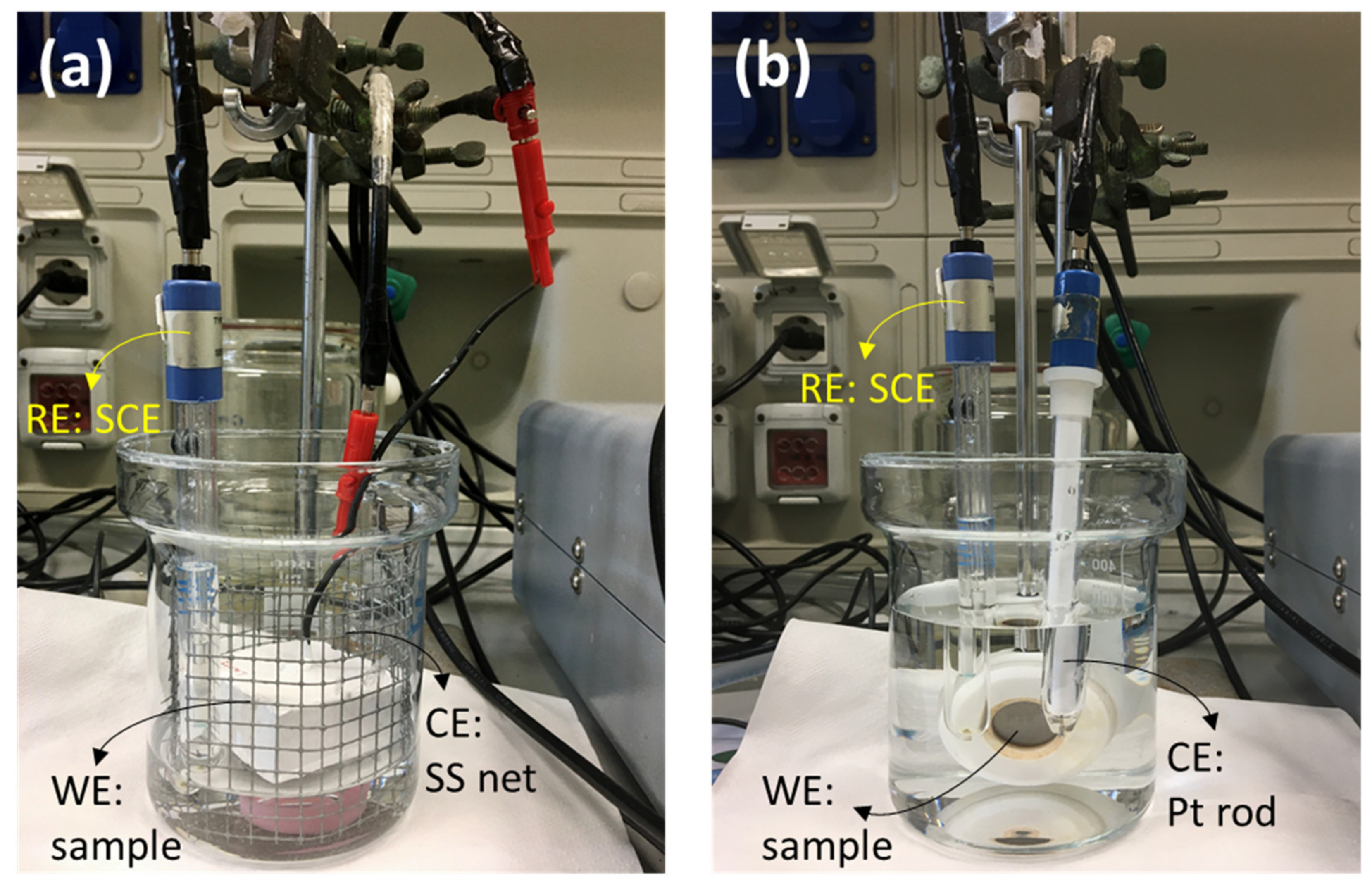
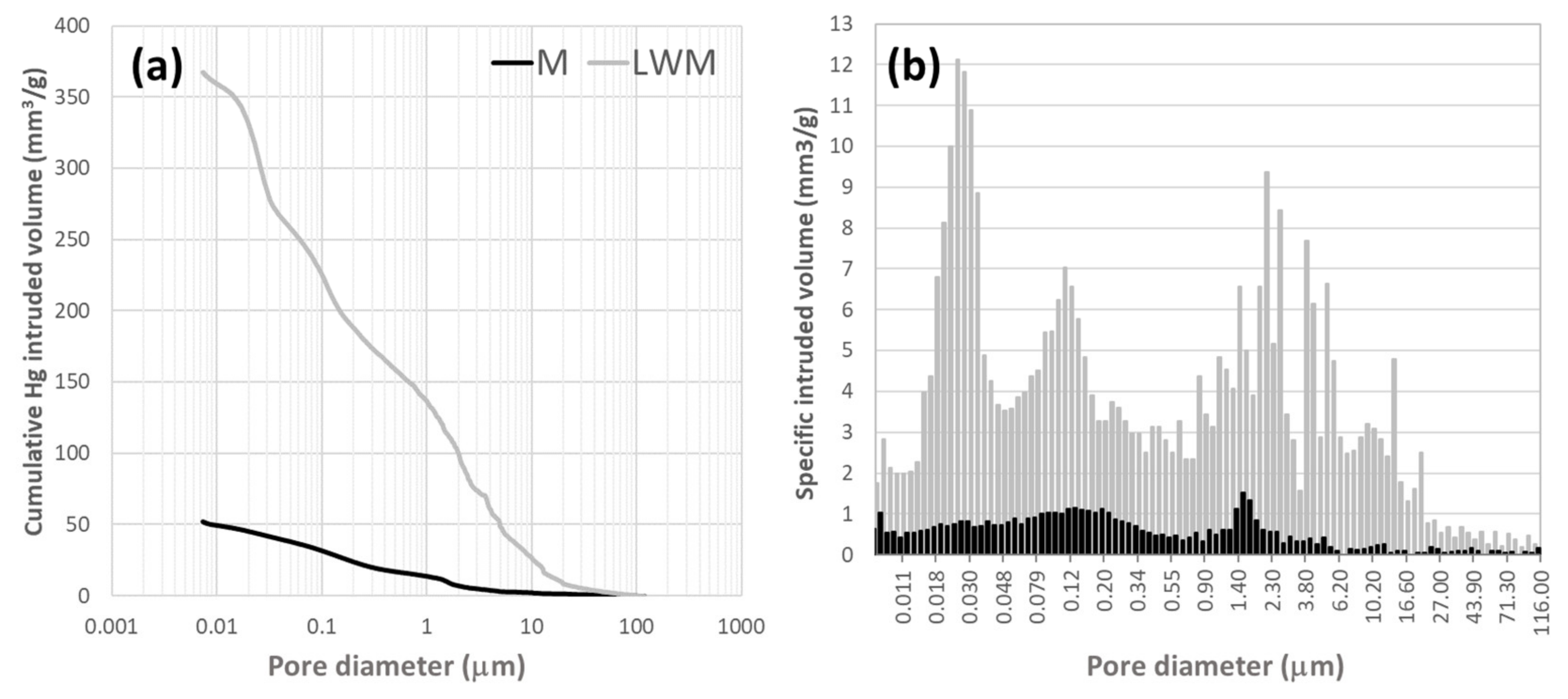
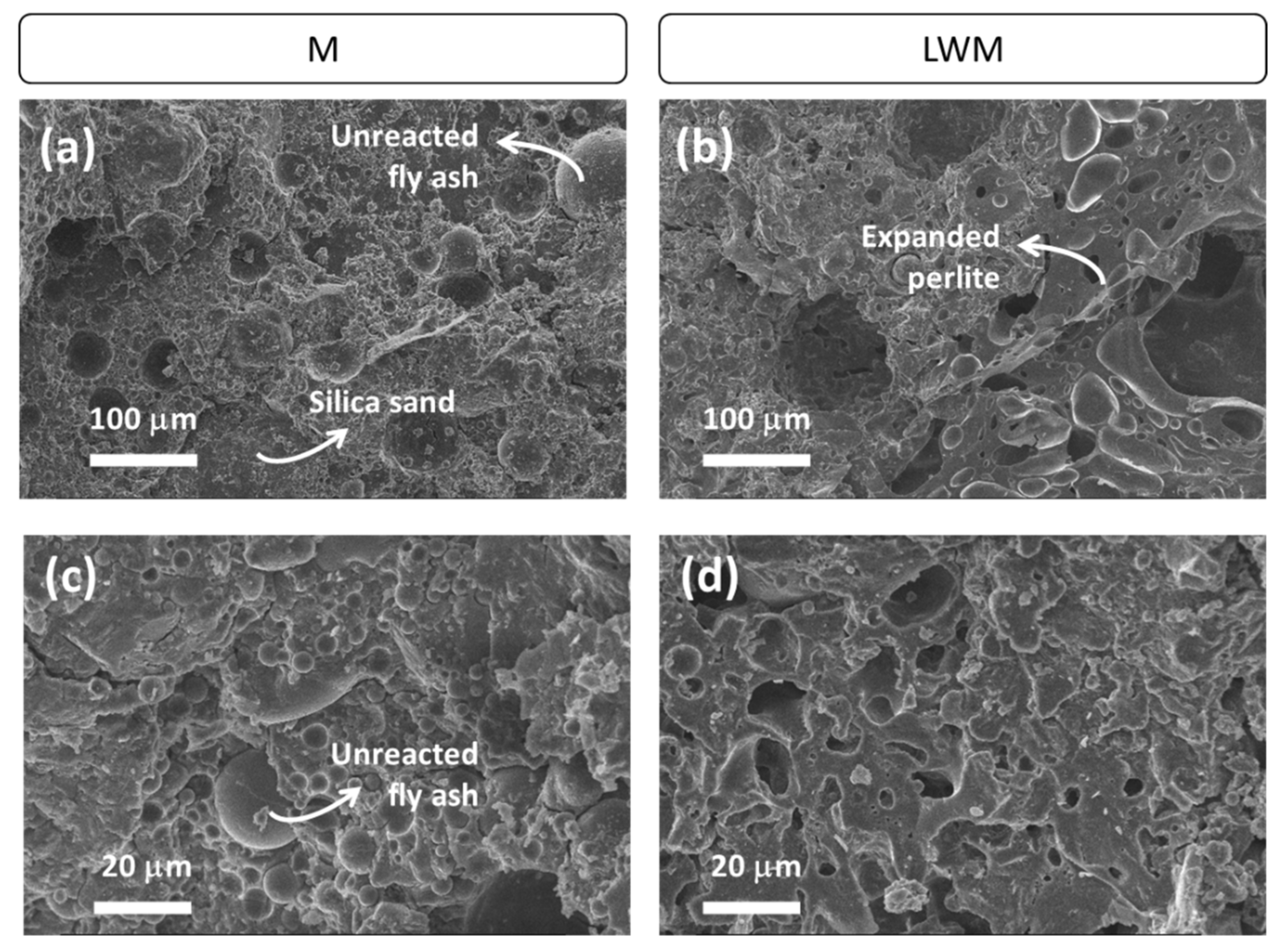
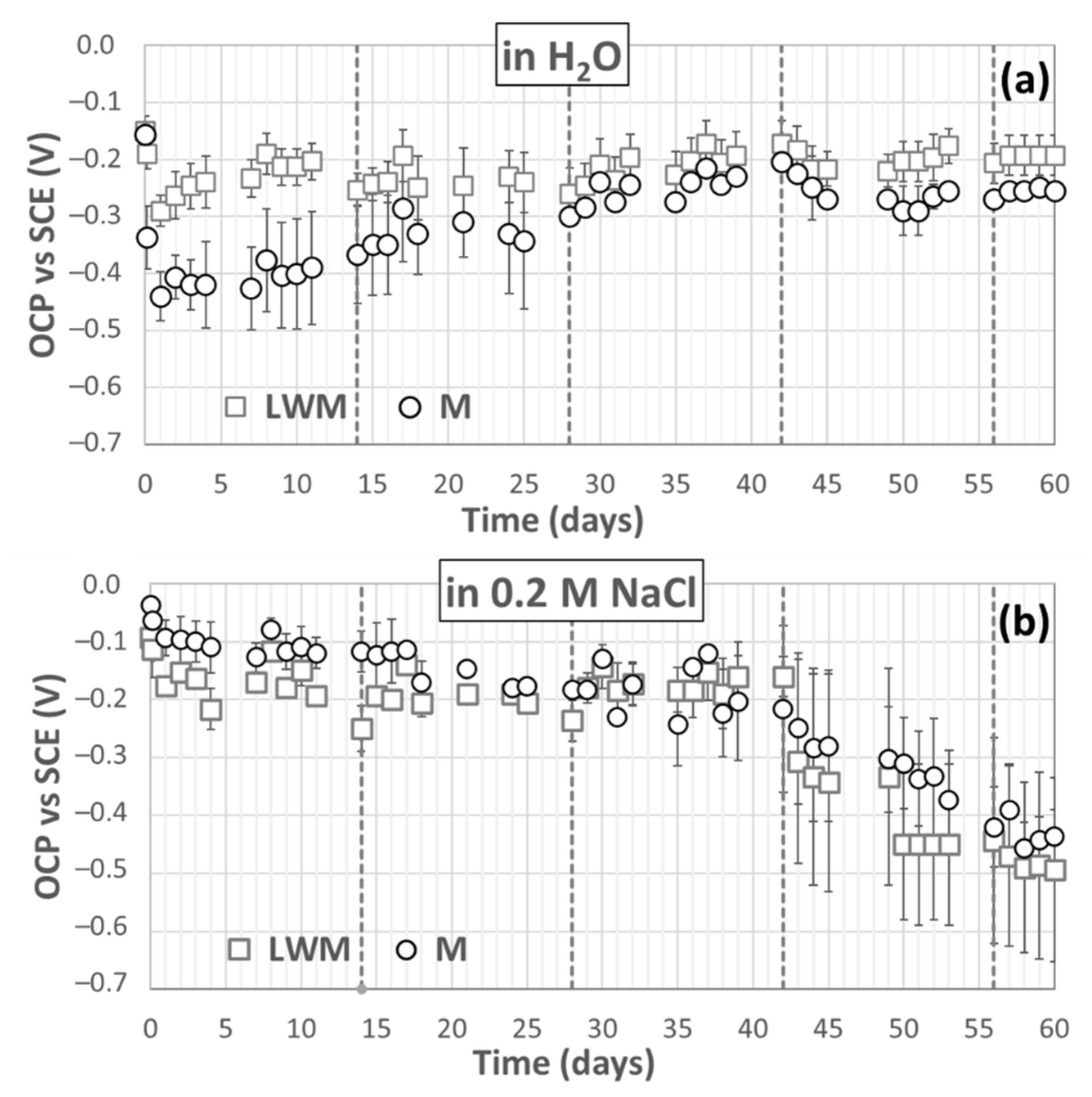
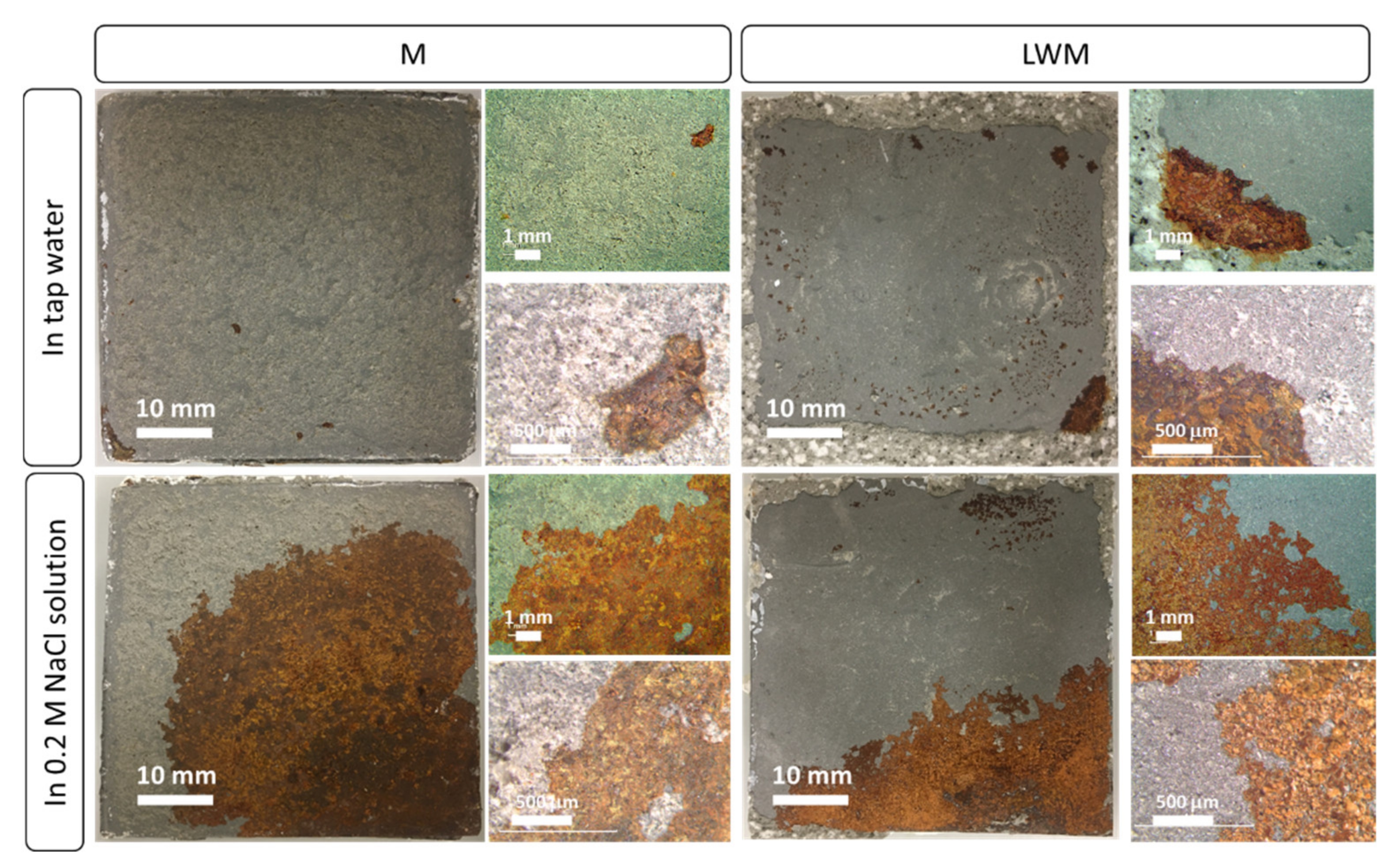
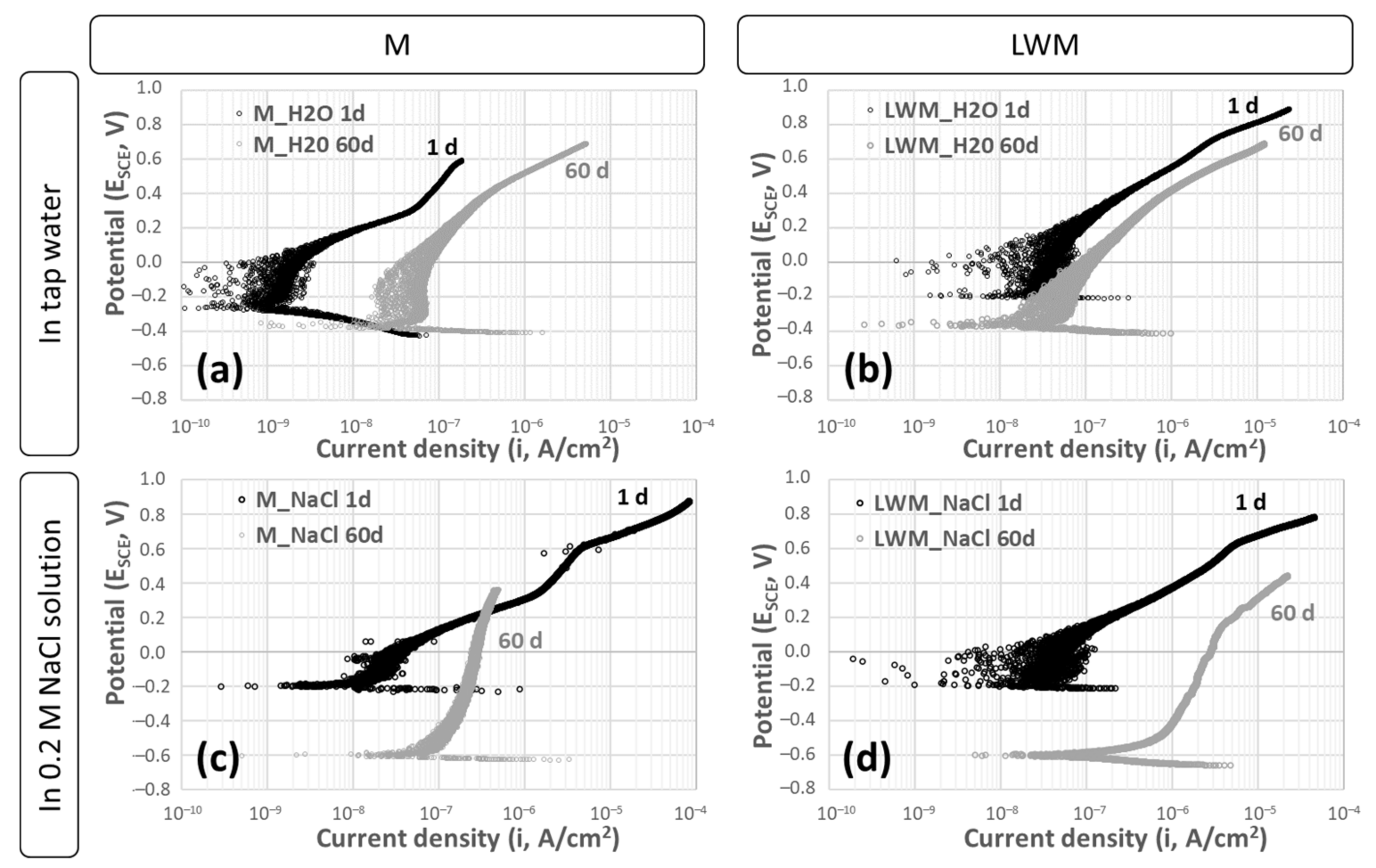
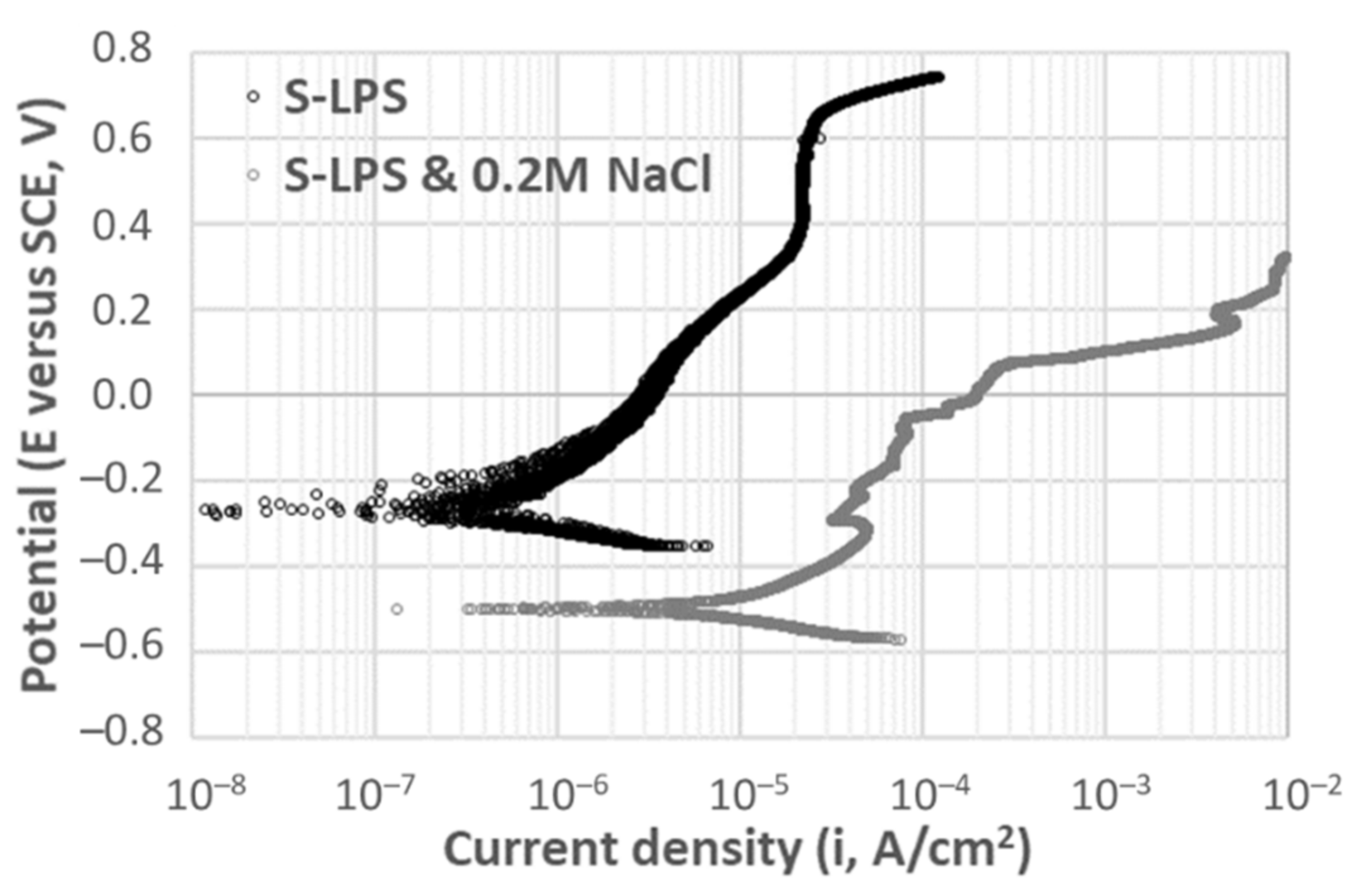
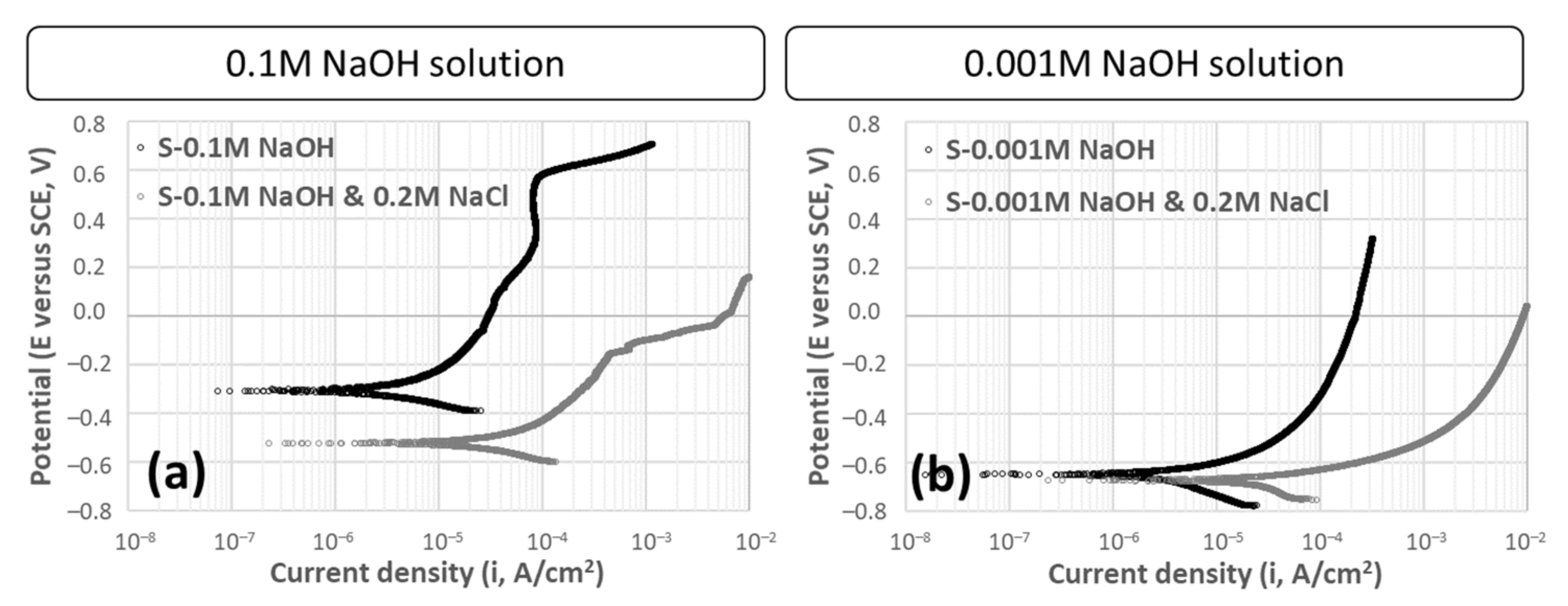
| Samples | Fly Ash (wt%) | 8M NaOH (wt%) | Sodium Silicate (wt%) | Extra Water (wt%) | Silica Sand (wt%) | Expanded Perlite (wt%) | H2O2 (wt%) |
|---|---|---|---|---|---|---|---|
| M | 28.3 | 2.1 | 10.7 | 2.2 | 56.5 | - | - |
| LWM | 54.5 | 4.1 | 20.5 | 7.7 | - | 13.0 | 0.3 |
| Element | Concentration (mg/L) |
|---|---|
| Si | 2000 |
| Al | 6.1 |
| Ti | 0.1 |
| Fe | 0.6 |
| Ca | 4.4 |
| Mg | 0.7 |
| K | 166 |
| Na | 10,300 |
| S | 3800 |
Publisher’s Note: MDPI stays neutral with regard to jurisdictional claims in published maps and institutional affiliations. |
© 2021 by the author. Licensee MDPI, Basel, Switzerland. This article is an open access article distributed under the terms and conditions of the Creative Commons Attribution (CC BY) license (http://creativecommons.org/licenses/by/4.0/).
Share and Cite
Masi, G. Steel Corrosion Behavior in Light Weight Fly-Ash Based Alkali Activated Mortars. Appl. Sci. 2021, 11, 1908. https://doi.org/10.3390/app11041908
Masi G. Steel Corrosion Behavior in Light Weight Fly-Ash Based Alkali Activated Mortars. Applied Sciences. 2021; 11(4):1908. https://doi.org/10.3390/app11041908
Chicago/Turabian StyleMasi, Giulia. 2021. "Steel Corrosion Behavior in Light Weight Fly-Ash Based Alkali Activated Mortars" Applied Sciences 11, no. 4: 1908. https://doi.org/10.3390/app11041908
APA StyleMasi, G. (2021). Steel Corrosion Behavior in Light Weight Fly-Ash Based Alkali Activated Mortars. Applied Sciences, 11(4), 1908. https://doi.org/10.3390/app11041908





